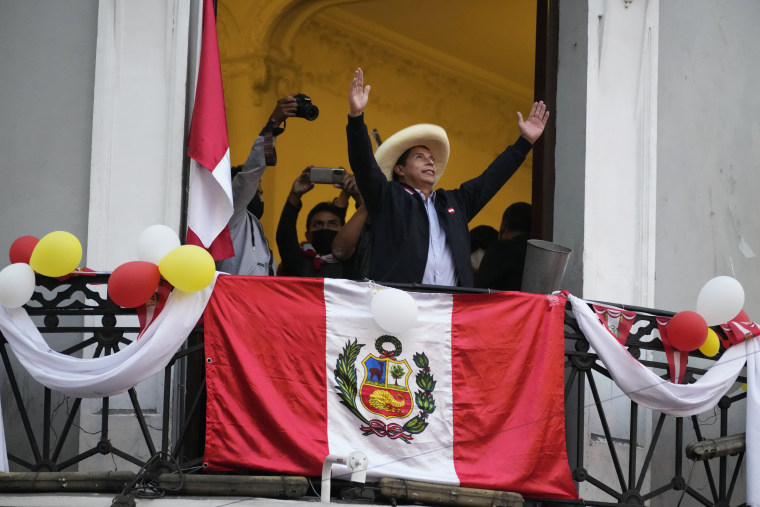More than a week after the second round of the presidential election in Peru, the vote count has reached 100%. According to the results of the electoral body of the country, the candidate from the “left forces” Pedro Castillo won 50.125% of the vote, which determines his victory. Why do many Peruvians disagree with this decision? How will the political course of the Latin American country change?
On Tuesday, the National Electoral Processes Office of Peru (Spanish – Oficina Nacional de Procesos Electorales, ONPE) provided a 100% vote count, according to which the candidate from the left party “Free Peru” (Spanish – Peru Libre) Pedro Castillo (Spanish – José Pedro Castillo Terrones) is in the lead with a score of 50.12%, which is 8 835 579 votes; and his main opponent, the far-right conservative of the party “Popular Power” (Spanish – Fuerza Popular), Keiko Fujimori (Spanish – Keiko Sofía Fujimori Higuchi) gets 49.87%, which is equivalent to 8 791 521 votes. Thus, Castillo managed to win by a margin of only 44 058 votes. However, the winner of the electoral process has not yet been officially announced.
Last Wednesday, Keiko Fujimori announced that it was demanding the annulment of 802 voting acts, amounting to roughly 200 000 votes. According to the Peruvian media “Ojo Publico”, the party “Free Peru” also filed 148 electoral irregularities in order to annul a certain number of votes.

These annulation claims are submitted to special election commissions dispersed throughout the country. The institutions have three working days to decide on the appropriateness of their consideration. Then the political party has three more days to appeal any decision, and, finally, the National Electoral Jury (Spanish – Jurado Nacional de Elecciones, JNE) will also have three days to consider the appeal in this case. According to the executive director of the Peruvian Institute for Electoral Law (Spanish – INSTITUTO PERUANO DE DERECHO ELECTORAL – IPDE) Jose Manuel Villalobos, such a process on the invalidity of voting acts could delay the announcement of the winner by about two weeks.
On Tuesday, hours after the National Electoral Processes Office had counted 100% of the vote, Castillo addressed his followers from the balcony of the “Free Peru” headquarters in downtown Lima. In his speech, he stressed that “the time has come for the largest unity of the Peruvian people in the fight not only against the pandemic, but also against other “pandemics” that have occurred over these 30 years”. According to him, Tuesday evening should be not only a joyful event, but also filled with great responsibility. Pedro Castillo urged his supporters that “there is no need to be carried away by illusions or pretense that they should be cold-blooded, because a real battle is starting that will end inequality in Peru”. In addition, in his statement, Castillo appealed to the electoral authorities with a call for “once and for all to stop annoying the Peruvian people and respecting their will”.
For her part, Keiko Fujimori is confident that the actions she takes with regard to the electoral administration will ultimately lead to the victory of her candidacy. The leader of the ultra-conservative party “Popular Power” also reached out to her followers and noted that despite the emergence of the result, the most important thing was missing, namely the assessment of the unfinished actions that the National Electoral Jury should take in relation to the cancellation requests. “We trust the electoral authorities and, above all, we know that when they consider these irregularities, they will most likely agree with us”, Fujimori said. In addition, she urged her supporters to continue peaceful demonstrations in support of her candidacy.
How long the political struggle will last is not yet clear. Nevertheless, judging by the statements, none of the candidates intends to yield to the other. The rural teacher and trade union leader Pedro Castillo of the left-wing “Free Peru” party is now popular with Peruvians living in remote rural areas of the Latin American country. In turn, Keiko Fujimori still has a chance to win back the position thanks to the yet uncounted votes of Peruvians living abroad. A right-wing ultra-conservative party candidate “Popular Power” denounced possible irregularities and “signs of fraud” without providing evidence.

In his campaign program, the candidate from the radical left-wing Marxist party “Free Peru” promised to nationalize key sectors of the economy and raise taxes. During the election campaign, Keiko Fujimori tried to present Castillo to her supporters as a leader capable of transforming Peru into a new Venezuela or North Korea. The candidate from the “left” forces, speaking about his opponent, never tired of reminding his followers of the history of the Fujimori family and a series of corruption scandals associated with it.
It is worth recalling that Keiko Fujimori is the daughter of the former head of state, Alberto Fujimori (Alberto Ken’ya Fujimori), who is serving a prison sentence on charges of corruption and abuse of power. The “Popular Power” candidate is a supporter of the neoliberal model of the economy, which involves lowering taxes and encouraging entrepreneurial activity.
Peru has changed four presidents in the past three years. Seven of the last ten presidents of the South American country have been accused of corruption. A number of international media have more than once referred to the sad Peruvian tendency of recent years: “from the presidency to court”. In 2017, Alberto Fujimori was sentenced to 25 years in prison for crimes against humanity and corruption; Alejandro Toledo was accused of accepting bribes from the construction company “Odebrecht” and is expected to be extradited from the United States; Alan Garcia (Spanish – Alan Gabriel Ludwig García Pérez) committed suicide in 2019, when he was about to be arrested on corruption charges; Ollanta Humala (Spanish – Ollanta Moisés Humala Tasso) is prosecuted on charges of illegal financing of his election campaign; and Pedro Pablo Kuchinski resigned in March 2018 after being accused of receiving illegal payments from the Brazilian construction company “Odebrecht” and is currently under house arrest. Later, Martin Vizcarra (Spanish – Martín Alberto Vizcarra Cornejo) joined this long “black list”.
The next few days will show which way Peru will develop. However, one thing is very clear that the second round of voting, which took place on June 6, became an important milestone in the modern history of the South American state, because the results of this electoral process will determine the future fate of the Peruvian people. Now “at stake” is not just the struggle of the “left” forces seeking to take revenge against the ultra-right conservatives, but the main dilemma: what place will Peru occupy in the geopolitical configuration at the regional and international levels.


